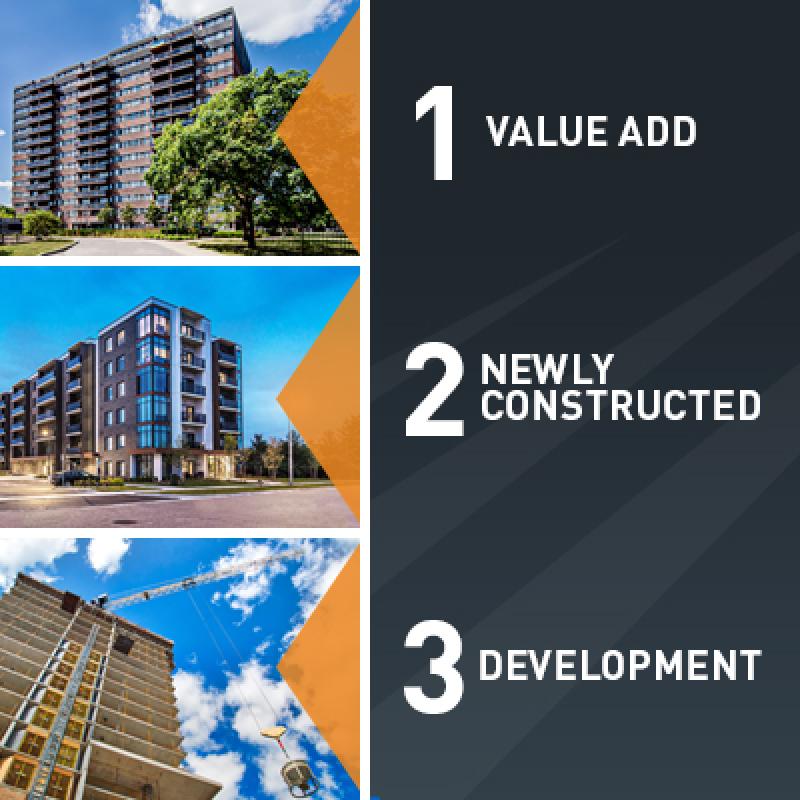
When looking to invest in multi-residential real estate, there are three types of apartments you’re likely to encounter: value add, newly constructed and development. Each category has its own merits and elements requiring specialized knowledge.
With the right expertise in every stage of the acquisition and management processes, each type of multi-residential apartment can be beneficial additions to a real estate portfolio. You need a healthy mix of all three categories to structure a diversified portfolio with complementary income streams that continually provide positive returns.
Let’s explore these three categories in more detail to show the different roles they perform in a portfolio.
Value-add
Value-add apartments are older buildings, often in need of repair, that are typically well-located in established neighbourhoods. They are generally available for a lower purchase price as they require updates and renovations making them capital intensive. As these properties are outdated, rents tend to be well below market value and expenses are typically around 50% of your revenue.
Value-add apartments can have numerous benefits. As improvements are made to the building, suites and common areas, you can see large increases in revenue as the rental gap to market improves. When renovating large portions of a building, you can benefit from economies of scale when ordering supplies which will lower your costs. Ultimately, residents benefit from the improvements made to the apartment, while investors benefit from increased value and revenue.
When considering a value-add apartment, there are things you need to know and to consider. Of the three categories, value-add apartments require the most up-front capital. Proper liquidity is crucial throughout the improvement stage as it can take several years to extract the value from this category of apartments. The property may even be cash flow negative in the early years as the property undergoes extensive renovations. This is normally offset by excellent gains in property value from the improvements. During periods of improvement, the property requires more resources and active management.
Newly constructed
The next category is newly constructed apartments. These are new buildings usually with modern designs and layouts. They tend to be more energy efficient and can include condo-like amenities (gym/pool/in-suite laundry/recreational areas). As everything is new, the expenses are typically around 30% of revenue versus the characteristic 50% of older/value-add buildings. Less maintenance is required for these properties and there are often vendor warranties in place that cover many unforeseen issues that arise.
This category of apartments has the benefit of positive cash flow right away as no major renovations are needed. Newly constructed properties command higher occupancies, higher rents and attract higher quality tenants with longer tenancies. Rents are closer to market value and aren’t subject to rent control in most markets so rents can increase along with the market. These buildings have higher operating margins meaning there is less financial risk.
Newly constructed apartments are more expensive to buy but don’t generally require any or very little additional upfront capital. With a lower rental gap to market, opportunities to improve your revenue stream through improvements to suites are limited, unlike with value-add apartments. With condo-like amenities you often need additional property management to maintain the facilities which impacts your operating costs.
Development
The final category is development. Development generally takes place on vacant or underutilized land. With development, you can build the apartment to your desired specifications. Development allows you to eventually end up with a new property for less capital than it would take to buy a newly constructed building that’s already operational.
A major benefit of development is that it offers the highest profit - potentially 20%+ average return per year. With the highest return on investment, you can double your money by the end of the project term. With many areas in dire need of housing units, governments often offer preferential financing to encourage the development of apartments.
Through development, you can build a property with suites tailored to modern preferences and trends which will allow you to attract the best possible tenants and command higher occupancies. Although, unlike the other two categories, with development there is no profit until the project is complete and completion can take five or more years. It also requires the highest level of expertise as you must oversee all the development, construction work, perform all the due diligence and arrange for the approvals, permits and entitlements.
Another consideration is whether you’re going to keep and manage the apartment or sell it. If you decide not to sell the apartment at completion, you get a building for less than its market value. For example, a $100M building may only cost the developer $80M - $85M. It then operates like a newly constructed apartment.
Proper diversity is key
A properly diversified multi-residential real estate portfolio needs a healthy mix of all three categories to continually provide positive returns to investors. Equiton applies our expert acquisitions and management process to ensure that our Funds contain the right mix to build the wealth of our investors. Equiton’s Apartment Fund acquired seven properties in 2022. Three value-add apartments: Braemar Place, Park Square Apartments, and Ravine Park Apartments; three newly constructed apartments: URBN Lofts, Joseph’s Place, and Emerald Hills Landing; and one development: Maison Riverain. Find out how you can benefit from Equiton’s Apartment Fund.








